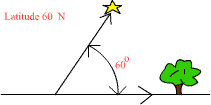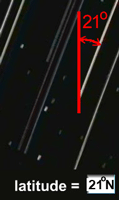


The art of establishing and finding coordinate locations is ancient. Polynesian navigators had (and have) a deep understanding of coordinate locations and the navigation guides to move between them. Rising and setting points of certain stars, their "houses", provide accurate bearings for navigation as do north-south lines that connect "meridian pairs," stars with the same celestial longitude. Latitude is determined by star positions in many ways. For example, in the northern hemisphere, the angle between the horizon and Polaris provides a close approximation of latitude. The angle at which stars rise and set also gives latitude in both hemispheres. You will become familiar with both of these methods in this exercise.
First, the star Polaris (meaning polar in Latin, also called the Pole Star, the North Star, Alpha Ursae Minoris, and Hoku-pa'a to the Hawaiians) remains in a seemingly fixed position in the sky within 2° of the North Celestial Pole. Because it lies in this position, latitude can be estimated by simply measuring the angle between an observer's horizon and the star itself, as shown in the diagrams below for several latitudes.
 |
 |
 |
|
subtropics
|
midlatitude
|
The North Pole
|
Use the information above to answer the following questions.
24. If Polaris lies directly overhead (90° above the horizon),
what is your approximate latitude? What is the name commonly given to the latitude
where you are located?
25. If Polaris lies directly in line with the horizon, what is your approximate
latitude? What is the name commonly given to the latitude where you are located?
26. If the angle between Polaris and the horizon is 40°, what is your approximate
latitude?
27. If the angle between Polaris and the point directly overhead (called the
zenith point) is 20°, what is your approximate latitude?
Another method of finding latitude using stars is to carefully observe their motion when they rise or set at the horizon at night. The rising (or setting) angle, measured from vertical, gives your latitude. Looking toward the east, an observer's latitude is simply the angle between a vertical line and the initial line followed by rising stars. The star streaks for Hawaii's latitude below illustrate the concept. In the Northern Hemisphere stars rise from left to right and in the Southern Hemisphere stars rise from right to left when looking eastward.
 |
 |
 |
 |
 |
 |
|||||
|
Hawaii 21° |
Scenario 1 |
Scenario 2 |
Scenario 3 |
Scenario 4 |
Scenario 5 |
Practice estimating the latitude for the scenarios above.
28. Scenario 1 latitude estimate ______________ Northern or southern hemisphere? _______________________
29. Scenario 2 latitude estimate ______________ Northern or southern hemisphere? _______________________
30. Scenario 3 latitude estimate ______________ Northern or southern hemisphere? _______________________
31. Scenario 4 latitude estimate ______________ Northern or southern hemisphere? _______________________
32. Scenario 5 latitude estimate ______________ Northern or southern hemisphere? _______________________